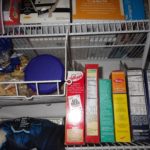I’m betting that there are many folks like me that put off cleaning the pantry by saying “someday I’ll have the time”. Right now some of us have that time unplanned time at home, so…attack the pantry.
Goals:
- Have the most nutritious meals possible from what’s on hand
- Don’t leave your home
- Eliminate food waste by using up what’s already there
- Save money on groceries
- Clean the pantry and freezer
- Teach kids meal planning
- Get organized
Start by taking everything out and putting on a near-by counter or table. Wipe down the empty shelves and vacuum the cracks and crevices.
Then come up with a strategy for how you want it arranged as it goes back in. A written inventory could help with meal planning and future shopping.
As you’re sorting and organizing the dry or canned foods you can check the dates. To set the record straight, the dates on food has nothing to do with food safety. There is nothing illegal about stores selling shelf staple foods that are beyond the date marked. (The one exception here is infant formula and some baby food.)
Packages frequently have words like “best by” or “use by” on them. Note that it doesn’t say “do not eat” after this date. These dates are provided by the food manufacturers as a way for you to judge the quality and freshness. Putting dates on packages is entirely at the discretion of the manufacturer and not required. After all, they would like you to eat their food when it is at its best.
Many unopened shelf-stable products will be of good quality long past the date. Use the dates to help you rotate them, and use the oldest first. Non-perishable foods such as sugar, dried beans, spices and canned goods do not spoil unless they are handled carelessly. They will lose quality and even nutritional value, however, if stored for a long time, even if stored under ideal conditions. So it’s best to use them as soon as possible.
In general, canned foods will be safe for a long time. The rule-of-thumb is high acid foods like tomatoes and fruits are good for 12 to 18 months. Other low acids foods like meats and vegetables will last two to five years.
Check the cans carefully. Pitch any that are dented, bulging, rusted or leaking. As with packaged dry foods, the quality and nutrition of canned foods may deteriorate over time, but if the can is in good shape there should be no food safety concerns. Check the boxed and packaged foods for rips, tears and signs that bugs or rodents have gotten inside.
I like to look at this as a challenge. Can you “get by” without going to the store for a couple of weeks? How many meals can you make from what’s on hand?
Cheryle Jones Syracuse, MS
Professor Emeritus, The Ohio State University
References:
Shelf-Stable Food Storage UDFS/FSIS https://www.fsis.usda.gov/wps/portal/fsis/topics/food-safety-education/get-answers/food-safety-fact-sheets/safe-food-handling/shelf-stable-food-safety/ct_index
